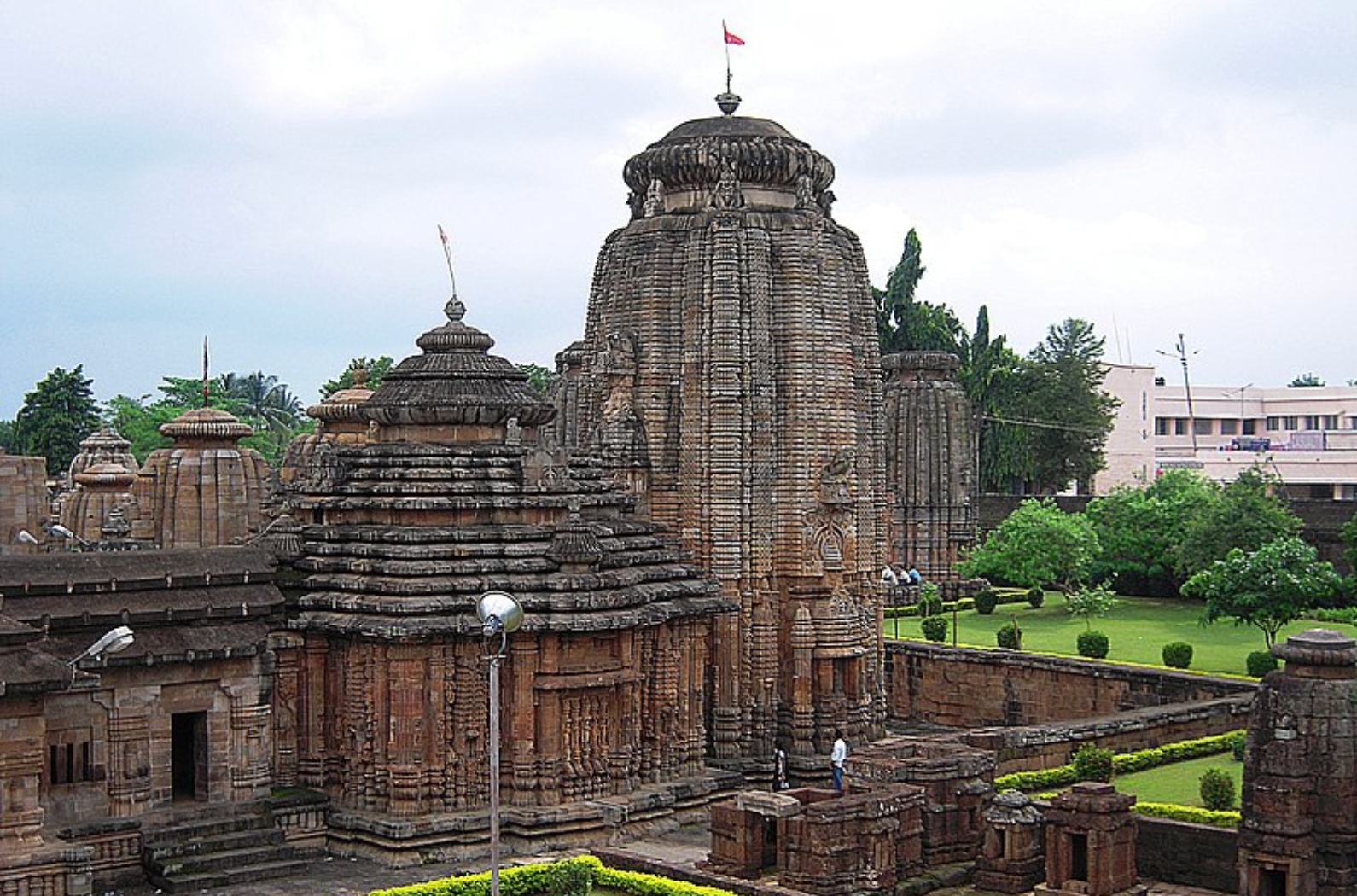When you travel through Odisha, you quickly realize that Bhubaneswar isn’t called the “Temple City of India” without reason. Every street seems to hold a shrine, every corner whispers a story from centuries past. But among them all, one temple towers above the rest — literally and spiritually. The Lingaraj Temple, with its awe-inspiring spire and deep sense of devotion, is the beating heart of Bhubaneswar.
I had heard about it long before setting foot in Odisha, but nothing prepared me for the grandeur and serenity that awaited. Let me take you through my journey into this magnificent temple, share a few travel tips, and hopefully inspire you to put it on your own list.

First Impressions – Lingaraj Temple
The first thing you notice about Lingaraj Temple is its sheer size. The central tower, or deul, soars nearly 180 feet into the sky. It’s visible from a distance, dominating Bhubaneswar’s skyline, almost like a guardian watching over the city.
Walking closer, the intricacy of the stone carvings begins to reveal itself. Every inch of the temple seems to be alive — gods, goddesses, mythical creatures, floral designs — all frozen in stone, yet somehow pulsing with energy. I found myself slowing down, stopping every few steps just to admire the craftsmanship.
There’s something humbling about realizing that these carvings were done almost a thousand years ago, during the 11th century, and yet they’re still standing strong, still commanding awe.
The Sacred Heart – The Lingam of Lord Shiva
Inside the sanctum, the temple houses the lingam of Lord Shiva, worshipped as Lingaraj — “the King of Lingas.” Devotees believe it is self-manifested (swayambhu), making it especially sacred.
Unlike many temples where rituals feel distant, here everything feels close, almost personal. Priests perform abhishekam with milk, water, honey, and sandal paste, while chants echo softly around the sanctum. Even if you’re not deeply religious, standing there you can’t help but feel connected to something bigger — a sense of continuity between the past, the present, and the eternal.
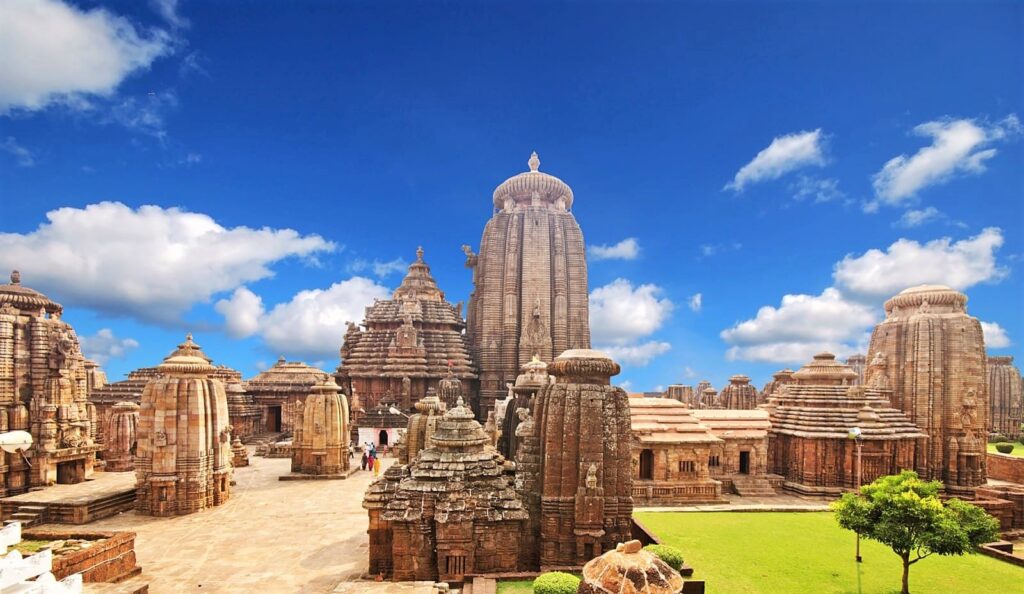
One of the most fascinating aspects of the Lingaraj Temple is how it blends different traditions. While the main deity is Lord Shiva, Lord Vishnu is also worshipped here in the form of Harihara, a combined representation of both gods.
I found this particularly moving because it symbolizes harmony — a reminder that devotion transcends labels. It’s not often that you see two major traditions of Hinduism represented so beautifully in one place.
The Temple Complex – More Than Just One Shrine
Don’t make the mistake of thinking Lingaraj Temple is only about the main sanctum. The complex is huge, with around 150 smaller shrines scattered within its walls. Each one tells its own story.
As I wandered, I stumbled upon shrines dedicated to Parvati, Ganesha, and other deities. The architecture varies in subtle ways, and the details are stunning. My favorite was watching the play of sunlight and shadows on the carvings — as if the temple changes character every hour of the day.
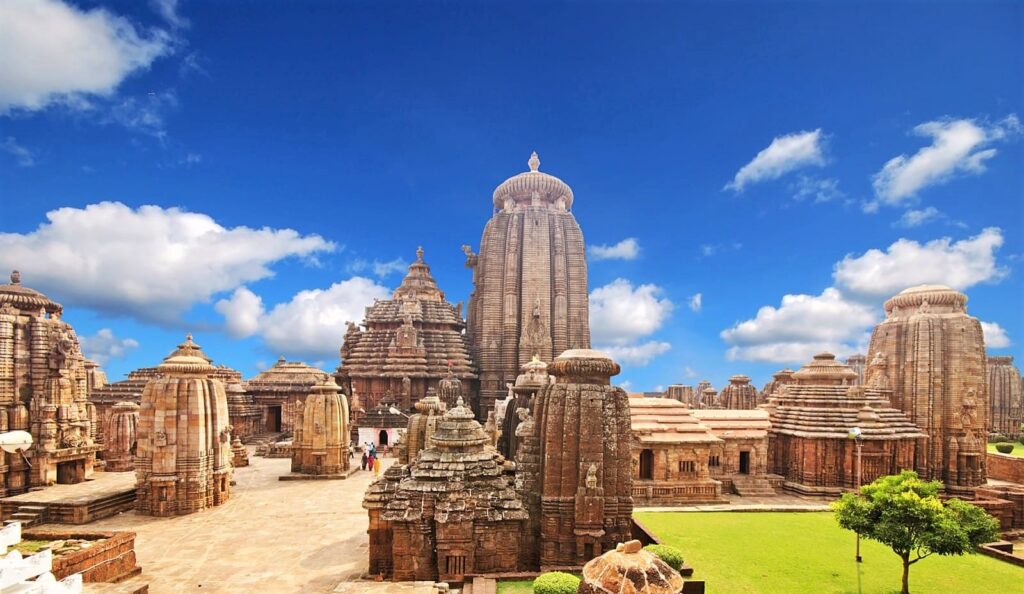
Rituals and Daily Life at the Temple
Visiting the Lingaraj Temple in Bhubaneswar isn’t just about architecture or history. Yes, the towering 180-foot spire is breathtaking, and the carvings will leave you in awe. But the real heartbeat of this temple lies in its daily life — the rituals, the sounds, the smells, and the people who make it come alive.
When I stepped into its stone courtyard, I quickly realized that this wasn’t a monument locked in the past. It was a living temple, where rituals happen every day with the same devotion they must have carried a thousand years ago.
Let me take you through a day inside Lingaraj Temple — from the quiet crack of dawn to the vibrant evening aarti — and share what makes its daily rhythm so unique.
Dawn at the Temple – The Awakening of the Lord
I still remember walking through the temple gates at dawn, when the city was barely awake. The air was cool, tinged with the smell of wet stone and jasmine garlands. Inside, everything was hushed, except for the soft clang of a bell being rung by an early priest.
Every morning begins with what devotees call the Mangala Arati, the first ritual where Lord Lingaraj is “awakened.” The sanctum doors are opened, lamps are lit, and sacred mantras echo in the dim light.
It feels like watching a household wake up — only here, the household belongs to the divine. I found it touching how tenderly the priests performed each action, almost as though they were waking up a beloved family member.
Morning Abhishekam – A Bath Fit for a King
Shortly after the arati, the lingam is bathed in a ritual called the Abhishekam. Water, milk, ghee, honey, and sandal paste are poured over the deity while conch shells are blown and bells ring in rhythm.
The fragrance in the air shifts — from incense to the earthy sweetness of honey, to the cooling aroma of sandalwood. Watching this, I realized that rituals here are as much about the senses as they are about devotion.
I leaned against a cool stone pillar, soaking in the moment, and thought: this is why people come back here again and again. Not just to pray, but to experience devotion in its most tangible form.
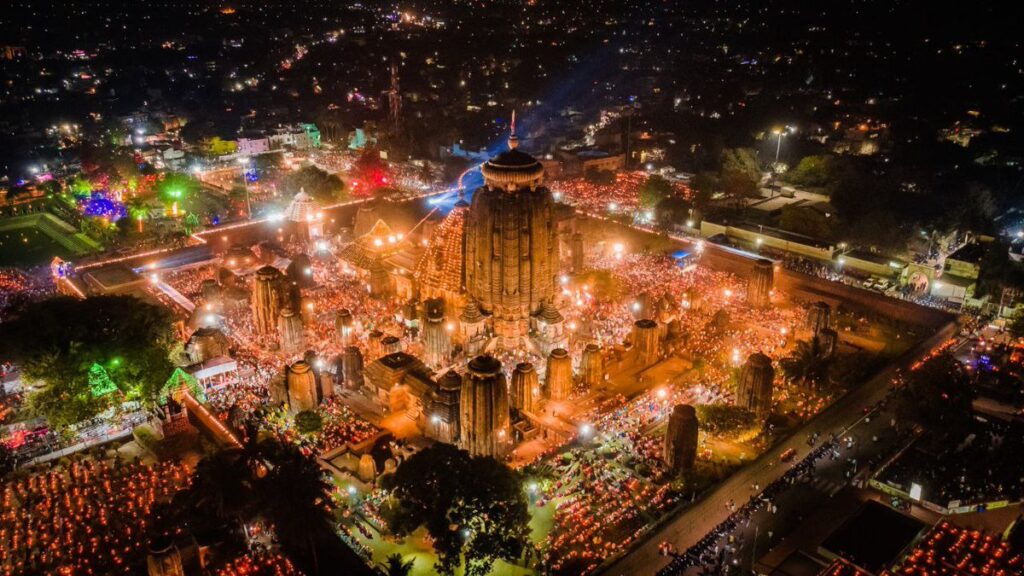
The Flow of Devotees – A Living River
By mid-morning, the temple fills with people. Some come with baskets of flowers, coconuts, and bel leaves, others with nothing but folded hands. There are women in bright saris, old men leaning on walking sticks, young children tugging their parents’ hands.
One thing struck me — no one seemed hurried. Unlike many tourist sites where people rush through, here everyone slowed down. Some sat quietly by the shrines, others waited patiently in line, and a few just gazed up at the towering spire as though drawing strength from it.
It felt less like visiting a temple and more like being part of a family gathering that’s been happening every single day for centuries.
Priests at Work – Guardians of Rituals
The rituals are carried out by a community of priests who have served here for generations. Watching them move around the temple is fascinating — each task is precise, practiced, and full of meaning.
Some priests carry trays of offerings, others chant hymns, some distribute sacred ash or prasad to devotees. It’s like watching an orchestra where everyone knows their role, and together they create harmony.
I once overheard a priest gently explaining to a visitor why bel leaves are so sacred to Lord Shiva. It reminded me that these priests aren’t just performers of rituals; they’re also keepers of knowledge, storytellers, and guides for those seeking deeper understanding.
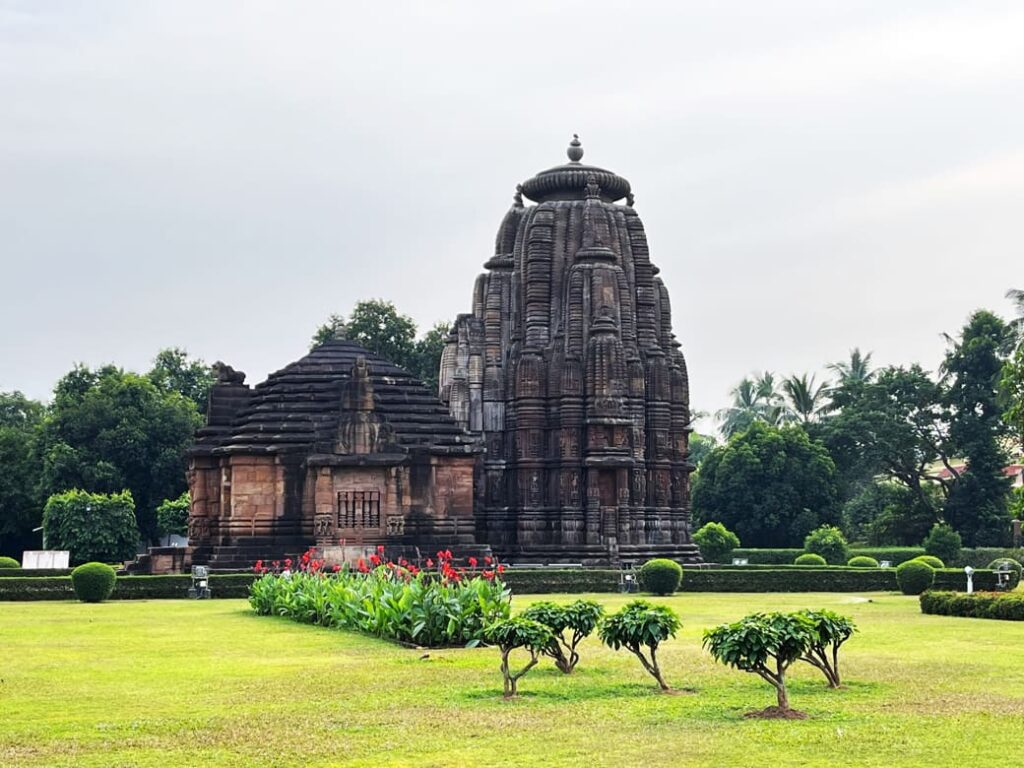
Noon Rituals – Feeding the Lord
Around midday, the temple performs the Bhoga ritual, where food is offered to Lord Lingaraj. This is no simple meal — it’s a full spread of rice, dal, vegetables, sweets, and more, cooked in the temple kitchen using traditional methods.
Later, portions of this offering are distributed as Mahaprasad, sacred food that devotees can take home or eat on the spot. I tried a small portion, and while the flavors were simple, the sense of sharing food with hundreds of others was powerful.
It’s not just nourishment for the body — it felt like nourishment for the soul.
The Afternoon Lull – A Temple at Rest
By early afternoon, the temple quiets down. The crowds thin, the priests take a break, and a gentle calm spreads over the courtyards.
This is a lovely time to simply sit in a shaded corner and watch the temple breathe. Birds flutter in and out of the spires, the stone walls radiate warmth, and the silence feels almost meditative.
If you’re planning a visit, I’d recommend spending some time here in the afternoon. It’s a reminder that even the busiest spiritual places have their moments of stillness.
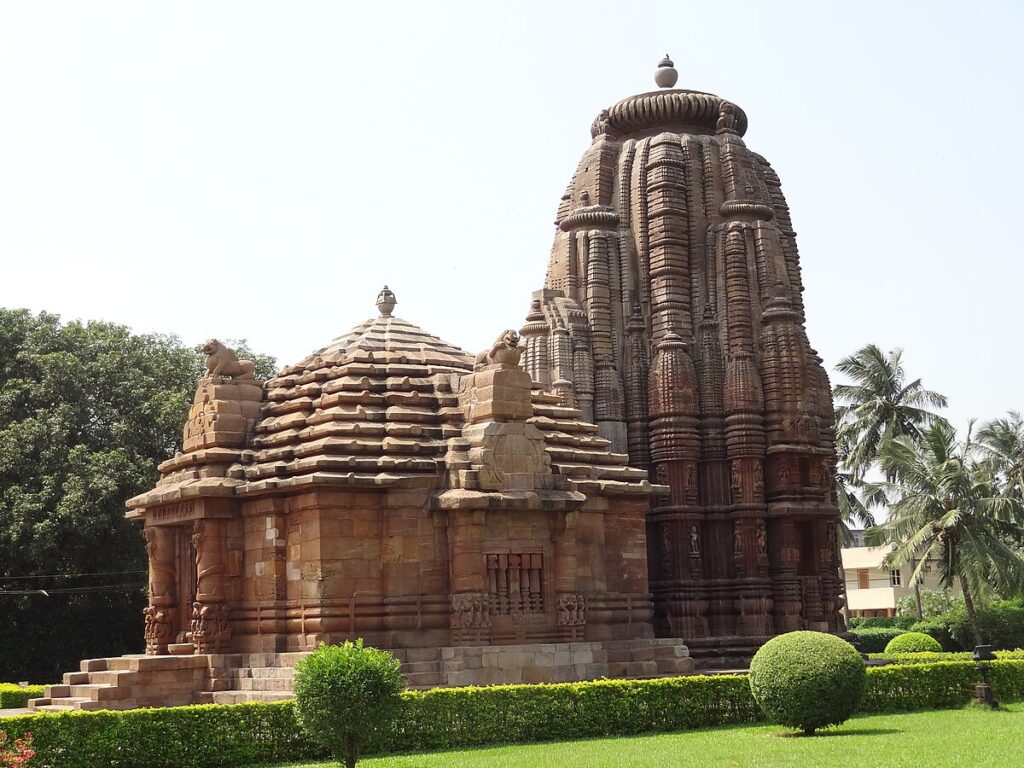
Evening Rituals – The Temple Comes Alive Again
As the sun begins to set, the temple wakes up from its afternoon lull. Lamps are lit, bells ring louder, and the air fills with the scent of camphor. This is the time for the Sandhya Arati, the evening worship.
I stood among a crowd of devotees, watching the priests wave large brass lamps in rhythmic circles before the deity. The flickering flames reflected on the stone walls, creating an almost mystical atmosphere.
Children clapped along with the chants, elders closed their eyes in deep prayer, and I found myself swaying to the rhythm without even realizing it. It was impossible not to be swept away by the energy.
Night Offerings – The Day’s Gentle Close
Before the temple doors close for the night, another offering of food and prayers is made. The deity is then symbolically “put to rest,” just as he was awakened at dawn.
There’s a softness to these final rituals — the chants are quieter, the crowds thinner, and the temple feels like it’s winding down after a long, vibrant day.
Walking out under the night sky, I felt a sense of completeness. The cycle of rituals had come full circle, and I had been lucky enough to witness it from beginning to end.
Festivals – When Daily Rituals Multiply
On ordinary days, the rituals themselves are captivating. But during festivals like Maha Shivaratri or Ratha Yatra, everything amplifies.
- On Shivaratri, the temple glows with thousands of lamps, and the night is filled with chants that continue till dawn.
- During the Ratha Yatra, the deities are taken out on huge chariots, and the rituals spill into the streets of Bhubaneswar.
I didn’t get to experience these festivals firsthand, but locals told me that the energy is overwhelming — like the temple’s daily heartbeat turning into a drumroll.
Festivals That Light Up Lingaraj
If you want to see the temple truly come alive, time your visit with one of its festivals.
The Lingaraj Temple in Bhubaneswar is a place that doesn’t just stand still in history—it breathes, moves, and comes alive, especially during its festivals. While the temple is an architectural marvel every day of the year, it is during celebrations that its spirit truly shines. The chants grow louder, the lights glow brighter, and the courtyards brim with devotion. If you’ve ever wondered when’s the best time to witness the magic of Lingaraj, let me take you through the vibrant festivals that light up this 11th-century wonder.
Maha Shivaratri – The Night of Shiva
If there’s one festival that defines Lingaraj, it is undoubtedly Maha Shivaratri. Imagine this: thousands of lamps glowing against the temple’s towering shikhara, the air heavy with the scent of incense, and bells ringing in harmony with the chants of “Har Har Mahadev.”
On this sacred night, devotees fast all day, waiting to offer prayers to Lord Shiva. The rituals extend late into the night as priests perform special pujas and the temple resonates with bhajans. The energy is electric yet deeply spiritual.
One of the most captivating sights is the deepamala, where rows of oil lamps light up the temple complex, creating a surreal glow. For travelers, this is the moment you realize that you’re not just a spectator—you’re part of something much larger. If you plan to visit Bhubaneswar, time your trip around Maha Shivaratri. It’s an unforgettable experience.
Chandan Yatra – A Celebration in Summer
Come summer, when the sun blazes down on Odisha, the temple begins its Chandan Yatra. This unique festival lasts for more than three weeks, starting on Akshaya Tritiya. The main ritual involves applying sandalwood paste to the idols and even to the temple walls, which brings relief from the summer heat and fills the air with a cooling fragrance.
But it doesn’t stop there. Every evening, the deities are taken in a grand procession to the Bindu Sagar Lake, just across from the temple. Decorated palanquins, music, and chanting turn the streets into a moving carnival of devotion. Watching the idols float on beautifully decorated boats in the lake is both serene and festive at the same time.
As a traveler, this festival gives you the chance to see the temple in a more community-oriented light, where faith spills beyond the temple walls and embraces the whole city.
Ratha Yatra – The Chariot Festival
When people think of Ratha Yatra, they often think of Puri. But Bhubaneswar has its own version of the chariot festival, and it’s just as thrilling. At Lingaraj Temple, the Rukuna Ratha Yatra takes center stage during Ashokashtami, usually in March or April.
The massive wooden chariot carrying Lord Lingaraj is pulled through the streets by thousands of devotees. The name “Rukuna” means “the one that does not turn,” symbolizing that the chariot never turns back during its journey. Instead, it completes its return trip a few days later.
Standing amidst the sea of devotees pulling the ropes, chanting, and dancing to the beats of drums, you can feel the pulse of Odisha’s culture. For first-timers, it might feel overwhelming, but it’s one of the most immersive experiences of faith you can have in Bhubaneswar.
Kartik Purnima – Lights and Legends
When autumn fades into winter, the temple gears up for Kartik Purnima, another festival that fills the complex with radiance. Devotees believe that this day marks Lord Shiva’s victory over evil and the beginning of auspicious times.
From early morning, thousands gather for ritual baths in the holy Bindu Sagar Lake before offering prayers at Lingaraj. The evenings are the highlight—when devotees light tiny clay lamps around the temple and float them on the water. The reflection of flickering lamps against the calm lake, with the temple towering in the background, is a sight that stays etched in your memory long after you’ve left.
It’s also a time when families come together, and the festive air in Bhubaneswar makes you feel like you’ve stepped into a city-wide celebration.
Other Celebrations You Shouldn’t Miss
Apart from these big names, Lingaraj Temple has a vibrant calendar of smaller but equally meaningful festivals.
- Pashupatinath Puja: Special offerings are made to Lord Lingaraj, highlighting his form as Pashupatinath, the lord of animals.
- Shravan Month Mondays: Every Monday of the holy month of Shravan sees huge crowds lining up for darshan, as this period is especially sacred to Shiva.
- Makar Sankranti: The festival marking the sun’s transition into Capricorn is celebrated with special rituals and thousands of devotees thronging the temple.
Even if you don’t make it for the bigger festivals, catching the temple on one of these occasions can give you a glimpse into the rhythms of life here.
Practical Tips for Travelers
Here’s where the travel blogger in me kicks in. If you’re planning to visit Lingaraj Temple, a little preparation will go a long way.
- Entry Restrictions: Non-Hindus are not allowed inside the sanctum. However, don’t feel left out — there’s a viewing platform just outside the temple where you can admire the structure in its full glory.
- Best Time to Visit: October to March is ideal. The weather is pleasant, and major festivals often fall during this period. Avoid peak summer, as Odisha can get quite hot.
- Dress Code: Wear modest clothing that covers shoulders and knees. This is a deeply spiritual space, and locals appreciate visitors showing respect.
- Photography: Cameras are not allowed inside the temple premises. I found this to be a blessing in disguise — it forced me to soak in the details with my own eyes rather than through a lens.
- Timing: Early mornings are peaceful, while evenings are more vibrant. If you can, experience both.
Exploring Around Lingaraj
Your trip to Lingaraj Temple doesn’t have to stop at the temple gates. Bhubaneswar is full of architectural gems.
- Just nearby, the Bindu Sagar Lake adds a calming touch. Locals say all the sacred rivers of India symbolically merge here.
- The Mukteswara Temple, with its famous arched gateway, is another must-see, and often called the “Gem of Odisha architecture.”
- If history excites you, the Odisha State Museum is just a short drive away.
I combined my temple visit with a stroll around these spots, and it made for a perfect day.
Food and Local Delights
After a long temple visit, food is always on my mind. Bhubaneswar doesn’t disappoint. Around the temple, you’ll find stalls serving traditional Odisha sweets like chhena poda (roasted cottage cheese dessert) and rasagola.
For a proper meal, I recommend trying an Odia thali — rice, dal, vegetables, and fish curry served on a banana leaf. Simple, hearty, and satisfying. And of course, don’t leave without sipping on some refreshing sugarcane juice from a roadside vendor.
What Makes Lingaraj Special?
I’ve visited many temples across India, but what sets Lingaraj apart is its ability to balance grandeur with intimacy. Yes, the tower is massive, the carvings are extraordinary, and the festivals are huge. But at the same time, the temple feels approachable, human, and deeply personal.
It’s not just about history or architecture — it’s about the pulse of devotion that continues to flow, day after day, century after century.
FAQs
Q1. Where is Lingaraj Temple located?
It is in Bhubaneswar, the capital city of Odisha, also called the Temple City of India.
Q2. Who is worshipped in Lingaraj Temple?
The temple is dedicated to Lord Shiva, worshipped as Harihara (a combined form of Shiva and Vishnu).
Q3. When was Lingaraj Temple built?
It was constructed in the 11th century by the Somavamsi dynasty and later expanded by the Ganga rulers.
Q4. What is special about the temple’s architecture?
It is the largest temple in Bhubaneswar, built in classic Kalinga style with a towering 180 ft spire.
Q5. What are the temple timings?
The temple usually opens early morning (around 6 AM) and closes in the evening (around 9 PM).
Q6. Are non-Hindus allowed inside Lingaraj Temple?
No, entry is restricted to Hindus, but non-Hindus can view the temple from a platform outside.
Q7. What festivals are celebrated at Lingaraj Temple?
Shivaratri, Ratha Yatra (Ashokashtami), and Chandan Yatra are celebrated with great devotion.
Q8. Is there an entry fee for the temple?
No, there is no entry fee for devotees to visit the temple.
Q9. How can one reach Lingaraj Temple?
The temple is well connected by road; the nearest railway station is Bhubaneswar Junction, and the nearest airport is Biju Patnaik International Airport.
Q10. Why is Lingaraj Temple famous?
It is renowned for its spiritual aura, intricate carvings, and as a key example of Odisha’s temple architecture.

